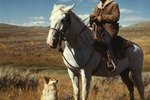Things You'll Need
Fabric shopping bag or denim cloth
1/2 yard quilted fabric
Straight edge or ruler
Straight pins
Fabric pencil
Scissors
Thread
Needle
Velcro
Fabric webbing (optional)
Sewing machine (optional)
At some point, your dog might develop rear-end weakness from an accident or illness or he might need assistance during recovery from surgery. A sling that elevates his rear and removes some weight from his hind legs can be beneficial during these times. A sling can be as simple as a rolled-up towel held beneath the dog’s abdomen (See References 1); however, padded slings with handles are more comfortable for your dog and easier for you to use.
Small and Medium-Sized Dog Sling
Cut the shopping bag from top to bottom along the fold on each narrow side. The bag should be able to lie flat when you are done cutting.
Place the quilted fabric wrong side up on a table or other flat, solid surface. Place the open bag, inside down, on top of the fabric. Pin the bag in place.
Use the straight edge or ruler and fabric pencil to mark a line 1 inch around the rectangular part of the bag. This line will be the outer edge of your lining. Do not trace around the outside of the bag handles. Cut the lining from the quilted material using the line as a guide.
Fold the edges of the quilted fabric under the bag material, evening the edges. Pin in place.
Sew the material in place. Trim and decorate as desired.
Large Dog Sling
Measure and record the length of your dog from the point immediately behind his shoulders to just in front of his hips. Add one inch to this measurement. This measurement will be the top center line of your fabric rectangle.
Measure and record the circumference of your dog’s chest immediately behind his elbows and the circumference of his waist immediately in front of his hips. Add 4 inches to each measurement. These measurements will be the front and back edges of your dog sling.
Measure and record the length of your dog’s body from behind his elbow to the point in front of his knee. Add 1 inch to this measurement. This measurement will be the bottom center line of the fabric rectangle.
Use the fabric pencil to transfer the measurements to the denim. The bottom center line should be placed at the center of the pattern. The front circumference measurement should be centered at one end of the line, parallel to the rear circumference measurement that should be centered at the other end of the center line. The top center line measurement should be used to complete the rectangle. Depending on the shape of your dog’s body, the pattern may have a slightly dished appearance on the front and rear edges.
Cut the denim fabric along the fabric pencil lines.
Place the quilted fabric wrong side up on a table or other flat, solid surface. Place the denim material, wrong side down, on top of the fabric. Pin the denim in place.
Cut the quilted fabric, using the denim material as a guide. Fold raw edges under 1/2 inch, pin in place. Sew around edges.
Put the wrap under your dog’s abdomen. Overlap the ends of the material, so the material is held firmly against his abdomen. Mark the placement of the ends with the fabric pencil. Sew Velcro in place at both ends, to ensure a secure closure.
Loop the webbing underneath your dog, about 1 inch behind his elbows. Stand next to your dog, with your arm in a comfortable position. Adjust the length of the webbing until his back is level and his feet rest comfortably on the floor. Overlap the ends to the width of your hands. Add 1 inch to this measurement and cut. Repeat this process with the webbing placed 1 inch in front of your dog’s hips.
Center the webbing on the bottom center line of the material. Pin and sew in place, ensuring that the material is free of wrinkles.
Overlap the webbing ends and sew in place.
Tips
Use fleece or synthetic lamb’s wool for alternate forms of padding.
Pad the handles of your large dog sling for greater comfort while walking your dog.
Warnings
Ensure that all material and padding is free of wrinkles. Your dog may develop sores if his skin rubs against uneven surfaces while walking.
References
Photo Credits
-
Mindklongdan/iStock/Getty Images



